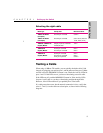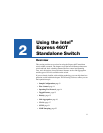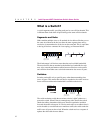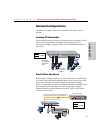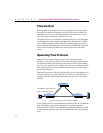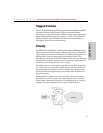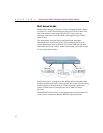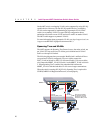
17
Using the Intel Express 460T Standalone Switch
CHAPTER 2
Using the 460T
Virtual LANs (VLANs)
A Virtual LAN is a logical network grouping you can use to isolate network
traffic so members of the VLAN receive traffic only from other members.
Creating a VLAN is the equivalent of physically moving a group of devices
to a separate switch (creating a Layer 2 broadcast domain). The advantage
of a VLAN is that you can reduce broadcast traffic for the entire switch, and
increase security, without changing the wiring of your network.
The 460T switch supports three types of VLANs: port-based, MAC-based,
and tag-based. See Chapter 5 for more information about creating and
configuring VLANs.
Port-Based VLANs
This is the simplest and most common form of VLAN. In a port-based
VLAN, the system administrator assigns the switch’s ports to a specific
VLAN. For example, the system administrator can designate ports 2, 4, 6,
and 9 as part of the engineering VLAN and ports 17, 19, 21, and 23 as part
of the marketing VLAN. The advantage of port-based VLANs is that they
are easy to configure and, because all changes occur at the switch, they are
transparent to the users. The 460T supports up to 12 port-based VLANs. A
port can belong to only one VLAN at a time.
12345678
910111213141516 1718192021222324
MDI
MDI-X
Left
Link = Solid Green
Activity = Blinking Green
Collision = Blinking Orange
Right
10Mbps = Solid Orange
100Mbps = Off
Status
Intel
®
Express 460T Standalone Switch
Status
Module A
Link\Act\Coll
Link\Act\Coll
Port 1 Port 2
VLAN 1:
Engineering
These devices
are members
of VLAN 2
VLAN 2:
Marketing
These devices
are members
of VLAN 1
If a user relocates, the system administrator reassigns the port to the new
VLAN. Another advantage is if a hub is connected to a port that is part of a
VLAN, all devices connected to the hub are also part of the VLAN. The
disadvantage is that there is no way to exclude an individual device on that
hub from becoming part of the VLAN.



